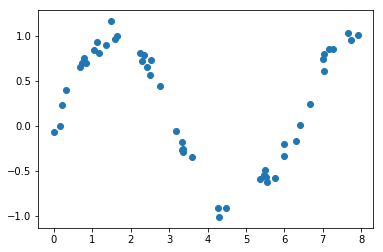I’ve been using sci-kit learn for a while, but it is heavily abstracted for getting quick results for machine learning. Particularly, sklearn doesnt provide statistical inference of model parameters such as ‘standard errors’. Statsmodel package is rich with descriptive statistics and provides number of models.
Let’s implement Polynomial Regression using statsmodel
Import basic packages
import numpy as np
import matplotlib.pyplot as plt
import pandas as pd
Create artificial data
rng = np.random.RandomState(1)
x = 8 * rng.rand(50)
y = np.sin(x) + 0.1 * rng.randn(50)
#Create single dimension
x= x[:,np.newaxis]
y= y[:,np.newaxis]
inds = x.ravel().argsort() # Sort x values and get index
x = x.ravel()[inds].reshape(-1,1)
y = y[inds] #Sort y according to x sorted index
print(x.shape)
print(y.shape)
#Plot
plt.scatter(x,y)
(50, 1)
(50, 1)

Running simple linear Regression first using statsmodel OLS
Although simple linear line won’t fit our $x$ data still let’s see how it performs.
\[y = b_0+ b_1x\]where $b_0$ is bias and $ b_1$ is weight for simple Linear Regression equation.
Statsmodel provides OLS model (ordinary Least Sqaures) for simple linear regression.
import statsmodels.api as sm
model = sm.OLS(y, x).fit()
ypred = model.predict(x)
plt.scatter(x,y)
plt.plot(x,ypred)

Generate Polynomials
Clearly it did not fit because input is roughly a sin wave with noise, so at least 3rd degree polynomials are required.
Polynomial Regression for 3 degrees:
\[y = b_0 + b_1x + b_2x^2 + b_3x^3\]where $b_n$ are biases for $x$ polynomial.
This is still a linear model—the linearity refers to the fact that the coefficients $b_n$ never multiply or divide each other.
Although we are using statsmodel for regression, we’ll use sklearn for generating Polynomial features as it provides simple function to generate polynomials
from sklearn.preprocessing import PolynomialFeatures
polynomial_features= PolynomialFeatures(degree=3)
xp = polynomial_features.fit_transform(x)
xp.shape
(50, 4)
Running regression on polynomials using statsmodel OLS
import statsmodels.api as sm
model = sm.OLS(y, xp).fit()
ypred = model.predict(xp)
ypred.shape
(50,)
plt.scatter(x,y)
plt.plot(x,ypred)

Looks like even degree 3 polynomial isn’t fitting well to our data
Let’s use 5 degree polynomial.
from sklearn.preprocessing import PolynomialFeatures
polynomial_features= PolynomialFeatures(degree=5)
xp = polynomial_features.fit_transform(x)
xp.shape
model = sm.OLS(y, xp).fit()
ypred = model.predict(xp)
plt.scatter(x,y)
plt.plot(x,ypred)

5 degree polynomial is adequatly fitting data. If we increase more degrees, model will overfit.
Model Summary
As I mentioned earlier, statsmodel provided descriptive statistics of model.
model.summary()
| Dep. Variable: | y | R-squared: | 0.974 |
|---|---|---|---|
| Model: | OLS | Adj. R-squared: | 0.972 |
| Method: | Least Squares | F-statistic: | 336.2 |
| Date: | Fri, 05 Apr 2019 | Prob (F-statistic): | 7.19e-34 |
| Time: | 11:59:50 | Log-Likelihood: | 44.390 |
| No. Observations: | 50 | AIC: | -76.78 |
| Df Residuals: | 44 | BIC: | -65.31 |
| Df Model: | 5 | ||
| Covariance Type: | nonrobust |
| coef | std err | t | P>|t| | [0.025 | 0.975] | |
|---|---|---|---|---|---|---|
| const | -0.1327 | 0.070 | -1.888 | 0.066 | -0.274 | 0.009 |
| x1 | 1.5490 | 0.184 | 8.436 | 0.000 | 1.179 | 1.919 |
| x2 | -0.4651 | 0.149 | -3.126 | 0.003 | -0.765 | -0.165 |
| x3 | -0.0921 | 0.049 | -1.877 | 0.067 | -0.191 | 0.007 |
| x4 | 0.0359 | 0.007 | 5.128 | 0.000 | 0.022 | 0.050 |
| x5 | -0.0025 | 0.000 | -6.954 | 0.000 | -0.003 | -0.002 |
| Omnibus: | 1.186 | Durbin-Watson: | 1.315 |
|---|---|---|---|
| Prob(Omnibus): | 0.553 | Jarque-Bera (JB): | 1.027 |
| Skew: | 0.133 | Prob(JB): | 0.598 |
| Kurtosis: | 2.351 | Cond. No. | 1.61e+05 |
Warnings:
[1] Standard Errors assume that the covariance matrix of the errors is correctly specified.
[2] The condition number is large, 1.61e+05. This might indicate that there are
strong multicollinearity or other numerical problems.
Plotting lower and upper confidance intervals
wls_prediction_std calculates standard deviation and confidence interval for prediction.
from statsmodels.sandbox.regression.predstd import wls_prediction_std
_, upper,lower = wls_prediction_std(model)
plt.scatter(x,y)
plt.plot(x,ypred)
plt.plot(x,upper,'--',label="Upper") # confid. intrvl
plt.plot(x,lower,':',label="lower")
plt.legend(loc='upper left')

Source
You can find above Jupyter notebook here